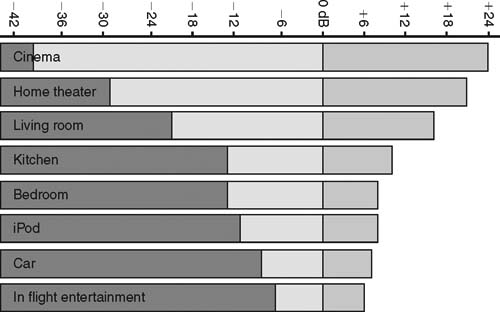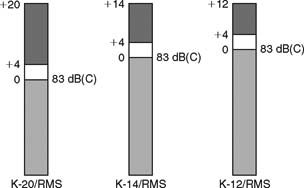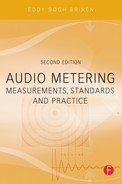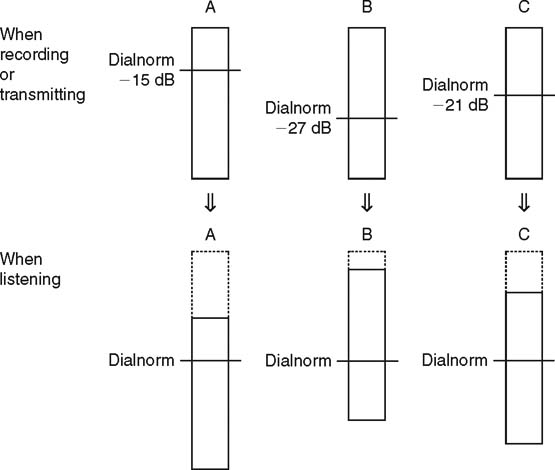Chapter | seventeen
Dynamic Scales
CHAPTER OUTLINE
It is a fact that the dynamic range can vary in different types of program material. Pop music can be very compressed and thus have a very limited dynamic range. Classical music and films mixed for the cinema have a large dynamic range. When recording, this means that the need for headroom will vary depending on the program material.

FIGURE 17.1 Dynamic ranges in various environments normalized with reference to dialog level. (Ref. Thomas Lund, TC Electronic.)
The listening location also affects the dynamic range that is necessary. If the material is being listened to in an automobile, then the dynamics must be limited in order for the audio to be heard above the background noise. If the material is to be played back in the home where it must not be too loud, there is similarly a need for limited range.
Over the years proposals have been advanced by a number of parties for implementing dynamic scales where it would be possible to utilize the dynamics of the storage media or the transmission line optimally. An applicable factory standard from Dolby will be described in the following, as well as a proposal from an American producer.
DTV
In the US, ATSC (Advanced Television Systems Committee) was introduced as a standard for DTV (Digital TV). In this system, it is possible to reproduce up to six channels of sound encoded in Dolby Digital.
Along with the digitized (and bit-reduced) sound, supplemental information is sent in the form of metadata. In popular terms it can be said that the information previously written on the box containing the tape is now included in the signal itself. What is interesting about the information that has been included as metadata is that, among other things, it can contain different possibilities for level, dynamic range, number of channels, etc., which can then be selected when the program is listened to.
The bit stream that contains the digital sound is divided into frames and blocks. The metadata can either be attached to each frame or to each block (compression data for example). Other metadata applies to the entire program (for example, information on level). It is the sender who decides which parameters will be associated with the program. However, the user can select from the possibilities offered and customize the sound per their requirements.
DIALNORM
One of the biggest problems with TV sound is the difference in level from program to program and station to station. When a viewer flicks through channels, the levels encountered are quite different, particularly with respect to speech. It is in a way quite natural, when considered in relation to full modulation, for the speech level (dialog) in a film to be at a lower level than the speech level in an interview program. One can of course decide always to have speech at a specific (low) level; however, that would mean a poor utilization of the system’s dynamic range.
Instead, “Dialnorm” – an abbreviation of dialog normalization e has been introduced. This lets the program material be recorded in an optimum manner, but the level at which the dialog is situated is specified. All the audio can subsequently be shifted in level so that the volume of the dialog is uniform from program to program.
The level at which the dialog is played back is also determined by the selected dynamic range. If the program is played back uncompressed (setting: “lin”), then the dialog level will lie at – 31 dBFS. If the program is played back with high compression (setting: “RF”), then the dialog level will lie at – 20 dBFS.
FIGURE 17.2 Dialnorm is used to adjust dialog (or the program’s average level) to the same listening level, regardless of whether the individual programs were recorded with different level placements, headrooms and dynamic ranges.
THE K SYSTEM
In an attempt to better utilize the dynamic range when recording and to have an indication of the modulation and subjective loudness, a proposal has been presented for a meter system by Bob Katz, an American whose experience includes many years of recording and mastering in the American music industry.

FIGURE 17.3 The K system. The three scales are specified here with an RMS detector. The scales can also be used in connection with the display of Leq and Loudness. *) X can be 20, 14, or 12.
The K system – named after him – builds upon three scales, namely K-20 with 20 dB headroom over 0 dB, K-14 with 14 dB, and K-12 with 12 dB headroom. On the scales, the color green is used below 0 dB, yellow between 0 and +4 dB, and red for over +4 dB. Each scale can be used with three different time/frequency weightings, named RMS, LEQA, and Zwicker.
Thus K-X*)/RMS is used with a frequency response of 20 Hz – 20 kHz ±0.1 dB.
K-X*)/LEQA uses A-weighting (IEC A) and an integration time of 3 seconds.
K-X*)/Zwicker uses, as the name suggests, Zwicker’s model for loudness. *)X can be 20,14, or 12.
For calibrated playback, pink noise at a signal level of 0 dB on the scale will correspond to 83 dB(C) in the listening position.
Note that the recording scale goes together with an acoustic listening/monitoring level specified in dB(C).

